Introduction
A diverse array of electoral rules governs American cities. How candidates are chosen for office affects who wins and who loses elections. Most cities select office holders through plurality rule – whoever gets the most votes wins. But an alternative, ranked-choice voting (RCV), has become increasingly popular. As of 2022, Maine and Alaska both use RCV in statewide and federal elections and more than 20 jurisdictions use RCV for at least some races, including large cities like San Francisco, Minneapolis, and New York. There are many variations of RCV (see Santucci (Reference Santucci2021) for an overview of different types), but the most basic idea of RCV is that instead of simply selecting their most preferred candidates, voters in an RCV election rank candidates running for the office. In most cases, voters can rank up to a certain number of candidates (as indicated by the ballot) or they can select only their first choice. For single-member districts, a candidate who receives more than half of the votes wins, but if no candidate wins a majority, the race goes to an instant runoff. In the runoff, the candidate with the least number of votes is eliminated; voters who ranked the eliminated candidate first have their second-choice ranking counted. This process continues until one candidate wins a majority of active (non-exhausted) ballots (FairVote 2022).Footnote 1
Electoral reform advocates argue that increasing the number of choices that voters can express can have multiple benefits for the electoral process – reducing partisan rancor and negative campaigning (Drutman Reference Drutman2020), bringing more diverse candidates into the political process (John, Smith, and Zack Reference John, Smith and Zack2018), expanding participation among young people (Juelich and Coll Reference Juelich and Coll2021), and increasing the representation of women (Kropf Reference Kropf2021; Spencer, Hughes, and Richie Reference Spencer, Hughes and Richie2015; Terrell, Lamendola, and Reilly Reference Terrell, Lamendola and Reilly2021). Others have noted that by asking voters to make multiple choices rather than one, RCV may be complicated, require more information, and be tiresome for voters (Tolbert and Kutznetsova Reference Tolbert and Kutznetsova2021). If similar to other complex voting rules, RCV may particularly harm the electoral prospects of candidates of color compared to white candidates, particularly in non-partisan and low-information settings (Crowder-Meyer et al. Reference Crowder-Meyer, Gadarian, Trounstine and Vue2020). If electoral reforms help one set of marginalized candidates (e.g., women candidates) but harm the prospects for candidates of color to win office, this could call into question the appeal of this change.
This article investigates the effect of two electoral rules – plurality and RCV – on voters’ preferences for candidates of color and how the information environment that voters face interacts with those electoral rules. We test the effect of RCV on voters’ choices and perceptions of representation using conjoint design survey experiments with a large, representative sample of American respondents. Our experimental design tests how voters make choices in environments with more and less information about candidates and when they vote under plurality or RCV rules. We use a survey experiment to test the impact of RCV on vote choice because it is difficult to identify the effects of RCV on voters’ decisions through observational studies alone given the non-random selection of jurisdictions using RCV. Jurisdictions that are more progressive, less polarized, or that already have existing multiracial coalitions might be more likely to adopt RCV and election outcomes might be due to these pre-existing conditions rather than the RCV institution alone.
We find that voting in a hypothetical RCV election (compared to a plurality election) has a minimal effect on whether experimental subjects choose a white candidate or a candidate of color as their first choice, consistent with observational findings that the adoption of RCV in California cities neither helped nor hurt win rates for candidates of color (John, Smith, and Zack Reference John, Smith and Zack2018; McDaniel Reference McDaniel2018), yet distinct from predictions based on how the complexity of RCV elections may affect voter application of prejudice to their voting decisions. When we analyze rankings below the first choice, we find that candidates of color and white candidates are ranked second equally often. However, any benefit candidates of color receive in lower-ranked RCV positions is not large enough to overcome the substantial benefit that white candidates have vis-à-vis candidates of color in being ranked first.
To see if candidates of color fared better when voters had more practice with RCV elections, we built a second survey wave into the research design. We find no significant difference between waves. Voters in both waves penalized candidates of color similarly to voters in plurality elections.
However, we do find that candidates of color were more likely to be selected when voters had more information about the candidates. We demonstrate that candidates of color are significantly penalized by voters when they have little information about candidates in both RCV and plurality elections – a penalty that is driven exclusively by white respondents and ideological moderates and conservatives. Providing additional information about the partisanship of candidates, a politically relevant piece of information that allows voters to make a choice based on something other than race, diminishes but does not eliminate the gap in support between white candidates and candidates of color.
This paper contributes to the discussion of electoral reform by demonstrating that in low-information elections, RCV is not likely to dramatically reshape voters’ choices for candidates of color (see also Benjamin and Burden Reference Benjamin and Burden2021), but grants that there may be other reasons for its implementation (such as changing candidates’ strategic calculations for entry or working in cooperation).
Voting cues and election structure
American voters are asked to make decisions under challenging circumstances like complex ballots and low information about candidates. Voters must decide between multiple candidates for multiple offices, while facing time and other resource constraints. Local newspapers are increasingly scarce, leading to a public less able to get knowledge about the civic and public issues in their areas (Rubado and Jennings Reference Rubado and Jennings2020). Facing a desire to participate but in a context of low information, voters regularly use heuristics such as candidate partisanship and ideology as well as candidate traits like race, gender, appearance, and occupation to decide who to support (Benjamin Reference Benjamin2016, Downs Reference Downs1957, Fiske et al. Reference Fiske, Cuddy, Glick and Xu2002, Kirkland and Coppock Reference Kirkland and Coppock2018, McDermott Reference McDermott1998, Reference McDermott2005, Popkin Reference Popkin and Grofman1995, Sen Reference Sen2017, Todorov et al. Reference Todorov, Mandisodza, Goren and Hall2005). Given the relative costs and benefits of attempting to become perfectly informed about every candidate in an election, the use of heuristics is an efficient shortcut, and using heuristics like partisanship can enable voters to make a voting decision in line with their political preferences and “vote correctly” even with little information (Lau and Redlawsk Reference Lau and Redlawsk2006).
In this experiment, we focus on how voters use a readily available cue about candidates – their race and ethnicity – that is present even when other cues are absent. Previous research shows that when voters use candidate race and ethnicity as heuristics, they project stereotypes onto candidates, particularly when policy and ideological information is not available. These perceptions may not always dampen support for candidates of color depending on the type of office (Sigelman et al. Reference Sigelman, Sigelman, Walkosz and Nitz1995), but previous experimental research finds that voters are more likely to support white candidates than candidates of color when there is little information available for voters to use (Crowder-Meyer et al. Reference Crowder-Meyer, Gadarian, Trounstine and Vue2020; Terkildsen Reference Terkildsen1993). When other candidate information is unavailable, voters use candidate identity cues to make assumptions about candidate priorities; for example, female candidates are perceived to care more about compassion issues (Alexander and Andersen Reference Alexander and Andersen1993; Huddy and Terkildsen Reference Huddy and Terkildsen1993) and Black candidates are perceived to care more about minority issues (McDermott Reference McDermott1998). Candidates of color and women are also perceived to be more liberal than substantively similar white candidates (Jacobsmeier Reference Jacobsmeier2014; McDermott Reference McDermott1997, Reference McDermott1998). Together, these perceptions may harm candidates of color among all but the most liberal voters.
The use of candidate race and ethnicity as voting cues may decrease support for candidates of color for various reasons, including basic prejudice against racial and ethnic minority groups (Huddy and Feldman Reference Huddy and Feldman2009, Kam Reference Kam2007; Yadon and Piston Reference Yadon and Piston2018). White Americans who endorse racial stereotypes view whites as more hardworking, more intelligent, and more politically experienced than members of other racial groups (Bobo et al., Reference Bobo, Charles, Krysan, Simmons and Marsden2012; Schuman, Steeh, and Bobo Reference Schuman, Steeh and Bobo1985), producing a preference for white candidates who are viewed as more experienced and better quality. These findings would be of particular concern if RCV elections were both low information and also created a more challenging voting experience, because the circumstances under which elections take place can influence how voters respond to candidate race and ethnicity. In particular, when voters have more information to draw on when casting their ballots – when they are provided with additional cues beyond candidate race and ethnicity such as partisanship or occupation – they rely more heavily on these more politically relevant cues (Alvarez, Hall, and Levin Reference Alvarez, Hall and Levin2018; Boudreau, Elmendorf, and MacKenzie Reference Boudreau, Elmendorf and MacKenzie2019; Crowder-Meyer, Gadarian, and Trounstine Reference Crowder-Meyer, Gadarian and Trounstine2020, Karnig and Welch Reference Karnig and Welch1980). On the other hand, some election circumstances may increase voters’ reliance on racial and ethnic stereotypes, producing potentially negative outcomes for candidates of color, particularly when the voting public is majority white (Lublin Reference Lublin1997). Racially polarized voting, where voters vote for candidates of their own racial or ethnic group, is more likely to occur when there are low levels of voting information and when party labels are absent (Hajnal and Trounstine Reference Hajnal and Trounstine2014). While many voters express support for racial equality – either due to a desire to display socially desirable behavior (Krumpal Reference Krumpal2013) or to genuine racial sympathy (Tesler Reference Tesler2016) – putting that support into practice when casting a ballot requires effort. Given the persistence of racial stereotypes, even voters who desire to behave in a non-racist way may nevertheless draw on negative racial stereotypes when making voting decisions. This is particularly likely when voters have fewer cognitive resources available when making their voting decisions (Crowder-Meyer et al. Reference Crowder-Meyer, Gadarian, Trounstine and Vue2020).
Given this, we might expect that different types of election rules would produce different levels of support for candidates of color. For example, at-large contests, in which voters have to select more than one candidate at a time, produce worse outcomes for Black candidates in real-world elections (Hajnal and Trounstine Reference Hajnal and Trounstine2005) compared to district elections where voters choose one candidate at a time (Crowder-Meyer et al. Reference Crowder-Meyer, Gadarian, Trounstine and Vue2020). In this paper, we investigate whether another type of election structure – RCV – similarly affects voter support for candidates of color relative to simpler plurality elections. We evaluate voters’ choices in low-information elections where candidate race is the primary cue available and in elections where party heuristics are also available, to examine whether any effects of candidate race on vote choice in RCV and plurality elections are maintained across these conditions.
In RCV elections, voters are permitted to rank the candidates on the ballot and candidates are elected through successive rounds of tabulation. Voters not only have to consider a list of candidates in order to select a favorite (their task in plurality elections) but they may also give deeper consideration to each candidate on the list in order to rank candidates in order of preference. Relative to plurality elections, RCV may require more information and more attention from voters. Because of the greater complexity involved in casting a ballot in a RCV election – potentially ranking multiple candidates, not just determining a specific favorite – RCV elections could result in lower voter support for candidates of color. Voters may have a more difficult time overcoming negative racial stereotypes in this more cognitively taxing environment. If this is the case, we would expect that voters in RCV elections would support candidates of color less often than voters in plurality elections.
On the other hand, participating in a RCV election may not have significant negative consequences for candidates of color or could even benefit them given electoral strategies that RCV might encourage. The need to rank candidates might force voters to slow down their thinking and thus enable voters to match their policy preferences more closely to candidates based less on heuristics or racial stereotypes. In plurality elections, voters may simply make a quick decision to support a single favorite candidate – a reflexive decision likely to be affected by heuristics. But, in RCV elections, the opportunity to examine each candidate more carefully in order to rank them by preference may lead voters to consider their choices more thoughtfully, bringing other information and preferences to bear in these decisions, particularly when additional information about candidates is available. Indeed, this careful consideration may prompt voters who explicitly prefer to promote racial equality (or those who wish to appear to do so) and voters choosing candidates based on perceived policy or ideological stances to display those preferences in their vote. In this case, the greater complexity of RCV elections may be balanced out by the increased processing that voters in RCV elections do if ranking their preferred candidates.
Furthermore, in RCV elections, candidates of color could work in coalitions to lessen racial polarization in voting or use campaign messages to ask voters to rank them even if they do not choose them first. Depending on election-specific factors, being ranked second or third (even if not ranked first), could potentially help candidates of color win seats. That said, in observational data, RCV seems to have only a modest effect on co-ethnic voting (McDaniel Reference McDaniel2018). The switch to RCV in California cities produced no significant change in racially polarized voting or win rates of candidates of color (Atsusaka and Landsman Reference Atsusaka and Landsman2021, John, Smith, and Zack Reference John, Smith and Zack2018) and slight increases in racial polarization between Asian and white voters (McDaniel Reference McDaniel2018) suggesting that voters may simply adapt their previous preferences and vote choices to a new electoral system. Given these results, and the unclear effect of RCV for voter decision-making, we would expect that voters in RCV elections would be no more likely to penalize candidates of color than voters in plurality elections. The experiments in this paper enable us to adjudicate between these competing expectations for the effects of RCV on voter support of candidates by race. They also allow us to explore which voters are least supportive of candidates of color and under what conditions. We investigate the role of voters’ ideology and race, as well as the role of partisan labels and additional practice with RCV in voters’ choice of candidates.
Methodology
To test how RCV affects the choices that voters make about candidates of color, we use a set of conjoint experiments that vary the race and gender of candidates in a hypothetical election, the type of election rule in the election, the type of office, and whether the election is partisan. In this experiment, we explore the effect of RCV on voters’ choices separately from the strategic environment that leads some candidates to run for office under RCV rules or not and measure actual choices that respondents make rather than their intentions or attitudes about candidates.Footnote 2 We use a 2 (RCV, Plurality election) x 4 (African American, Latino, Asian American, White candidate) x 2 (Man, Woman candidate) x 2 (Partisan, Non-partisan election) conjoint design experiment (Green, Krieger, and Wind Reference Green, Krieger and Wind2001, Hainmueller, Hopkins, and Yamamoto Reference Hainmueller, Hopkins and Yamamoto2014) that randomly assigns candidates with varying race and gender to respondents voting under randomly assigned electoral rules. Table 1 outlines the attributes of the candidates that respondents saw and what values those could take. Half of respondents saw candidate partisanship and half did not. All attributes are randomized separately from each other and within each wave.
Table 1 Conjoint Design Set Up – Qualtrics Sample, Fall 2020
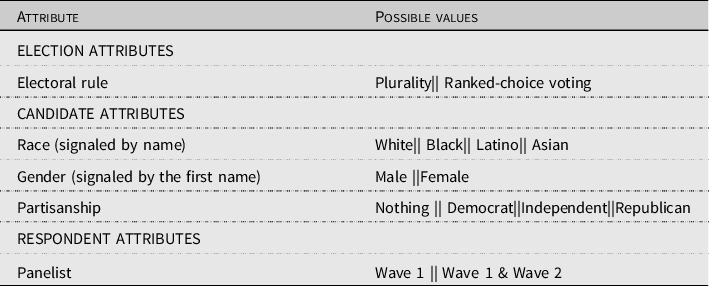
In our experiment, respondents were asked to act like voters in an election and each respondent was randomly assigned to either vote in a “ranked-choice election” where respondents had to rank all four candidates or a plurality election where respondents chose one (or two candidates) where the candidate (or two candidates) with the most votes “won” the election. This set-up is similar to the Australian system of preferential voting that is required for the House of Representatives (Australian Election Commission 2022). In typical RCV elections in the United States, voters are encouraged, but not required to rank all candidates. Ballot “exhaustion” rates, where voters rank fewer than the total number of candidates or only one candidate, are fairly high in RCV elections at the local level (ranging between 10–27%) (Benjamin and Burden Reference Benjamin and Burden2021). If voters choose to rank only a single preferred candidate, they essentially turn the RCV election into a plurality election. Thus, in this setting we would expect candidates of color to win at lower rates than white candidates given existing research. However, we seek to better understand how the process of ranking candidates in RCV elections affects support for candidates of color. So, to gain more experimental control and simulate what voters would do if they were motivated to select not just their top-choice candidates, we required voters to rank each candidate on the ballot in front of them. This generates a more complete understanding of relative preferences for candidates of different races, while sacrificing a small amount of external validity for certain voters in certain elections.
The outcome of interest in our statistical models is the probability that a candidate with a given set of characteristics (race, gender, partisanship, etc.) is “selected” by the voter compared to a candidate with a different set of characteristics. To measure the probability of choosing a candidate, we considered a candidate in an RCV race “selected” if they were ranked first (or first and second in the multi-candidate election). This is not necessarily which candidate would “win” if all voters’ full RCV rankings were to be utilized in ballot tabulation (something not possible in this experimental context), but it allows us to compare the choices voters make in RCV and plurality elections. When we focus on RCV elections alone, we are additionally able to compare second, third, and fourth place rankings across racial groups to better understand how candidates of color fare.
To test how experience with electoral rules influences vote choice, we also built in a panel component to the experiment.Footnote 3 Six weeks after the original study, we recontacted approximately one-quarter of respondents (N = 530), to vote again. We selected this recontact sample such that approximately one-third (185) voted in plurality elections in the first wave and two-thirds (345) voted in RCV elections in the first wave. The design of the second study was similar to the first, except that the second study had no randomization of the voting rule – everyone voted in RCV elections. This means that 185 respondents voted in two types of elections (plurality and then RCV), and 345 respondents voted in RCV elections twice.
In each wave, each respondent voted in three different types of elections: mayor, city council member election by district, and two city council members elected at-large.Footnote 4 These offices vary in executive versus legislative roles as well as the number of candidates elected – variations which have all been shown in previous research to affect the demographic characteristics of winning candidates. By asking respondents to make decisions quickly with limited information across a variety of different types of electoral circumstances, we are reproducing the decision-making process of many voters in lower-level elections, who typically have few incentives to devote much time or effort to their candidate selections (Downs Reference Downs1957, Schaffner, Streb, and Wright Reference Schaffner, Streb and Wright2001). Showing how voting decisions occur across a wide variety of electoral configurations allows us to generalize across many types of decisions that voters face at the ballot box.
At the beginning of the study, before the experimental component, respondents answered questions about their demographics, partisanship, and racial and gender attitudes. Prior to “voting” in the hypothetical elections, all respondents read an introduction about the role of city governments and what types of services they provide and what responsibilities cities have (see online appendix). Then, for each office, respondents saw a list of candidates identified by their names. Each name signaled the race and gender of the candidates.Footnote 5 Each election was on a separate screen. Half of respondents also saw the partisanship of the candidate while half of respondents saw no party cue.
Respondents were randomly assigned to vote using a plurality vote rule (i.e., candidate with the most votes wins) for all elections or RCV rule (i.e., candidates ranked, if no candidate reaches 50%, all votes reallocated until one candidate reaches 50%). Each respondent voted in all plurality or all RCV elections in wave one of the survey. In the plurality treatment, subjects chose their top choice for mayor and the district election, and their top two choices for the “at-large” election based on just candidate names (or candidate names plus partisanship in the partisanship condition). We did not expect people to be as familiar with how RCV works, so we provided an additional explanation for those in the RCV condition, created based on instructions provided to voters by election officials in several American localities where RCV elections currently occur. The text can be found in the appendix. The text of each RCV election prompt also included a reminder about the way that votes were reallocated, as can be seen in Figure 1 which displays a screenshot of a type of decision that a respondent received in a ranked-choice election. This design is similar in design to RCV electoral ballots like the one from Maine that we show in Figure 2.
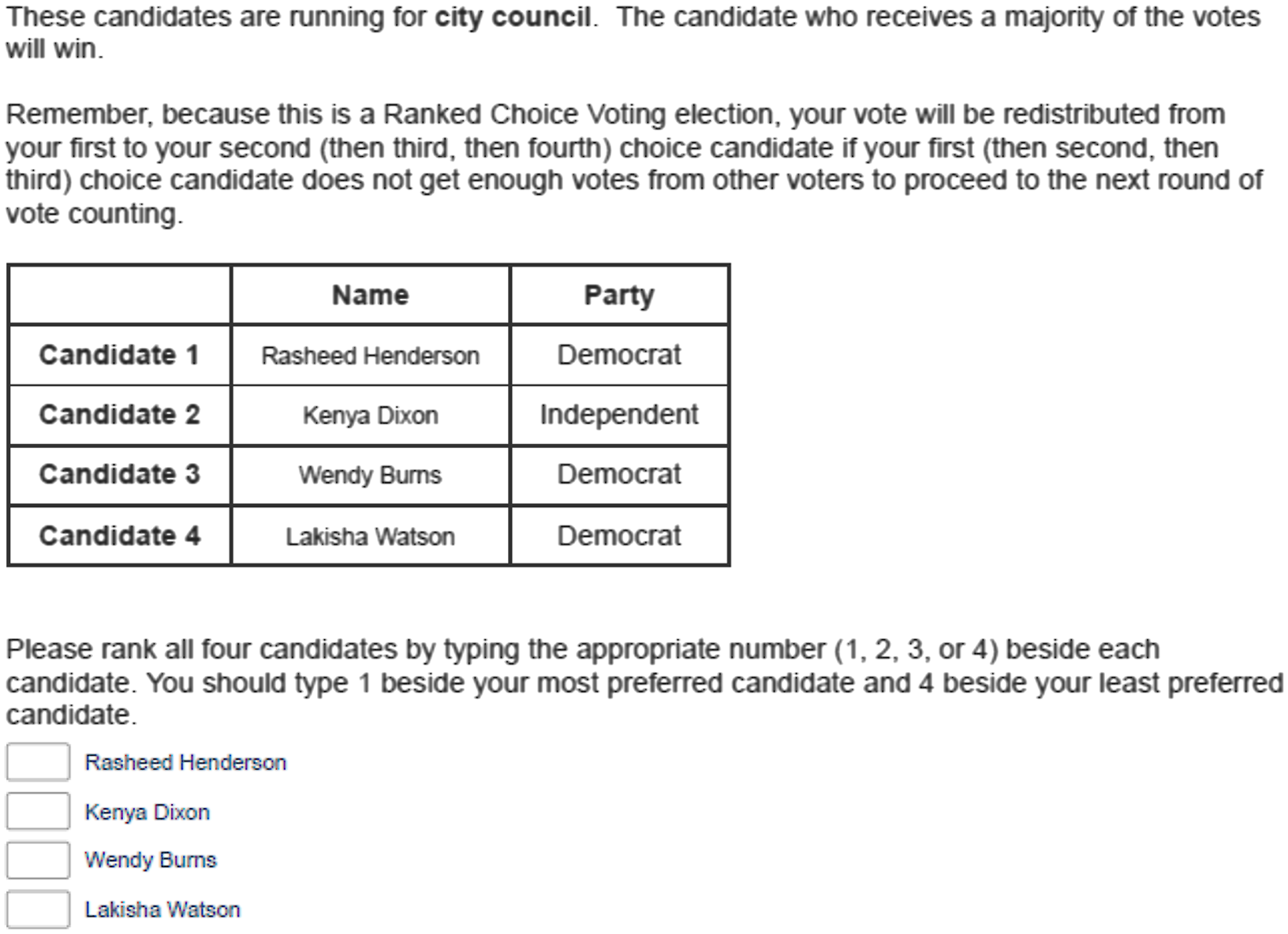
Figure 1. Experimental screenshot for RCV.
Participants in the “RCV” district condition are presented with a set of four candidates and have to rank all four. The plurality condition is similar except that voters choose just one candidate for the district city council and the mayoral race. For the at-large city council race, the top two ranked candidates or candidates with the top percentage of votes win.
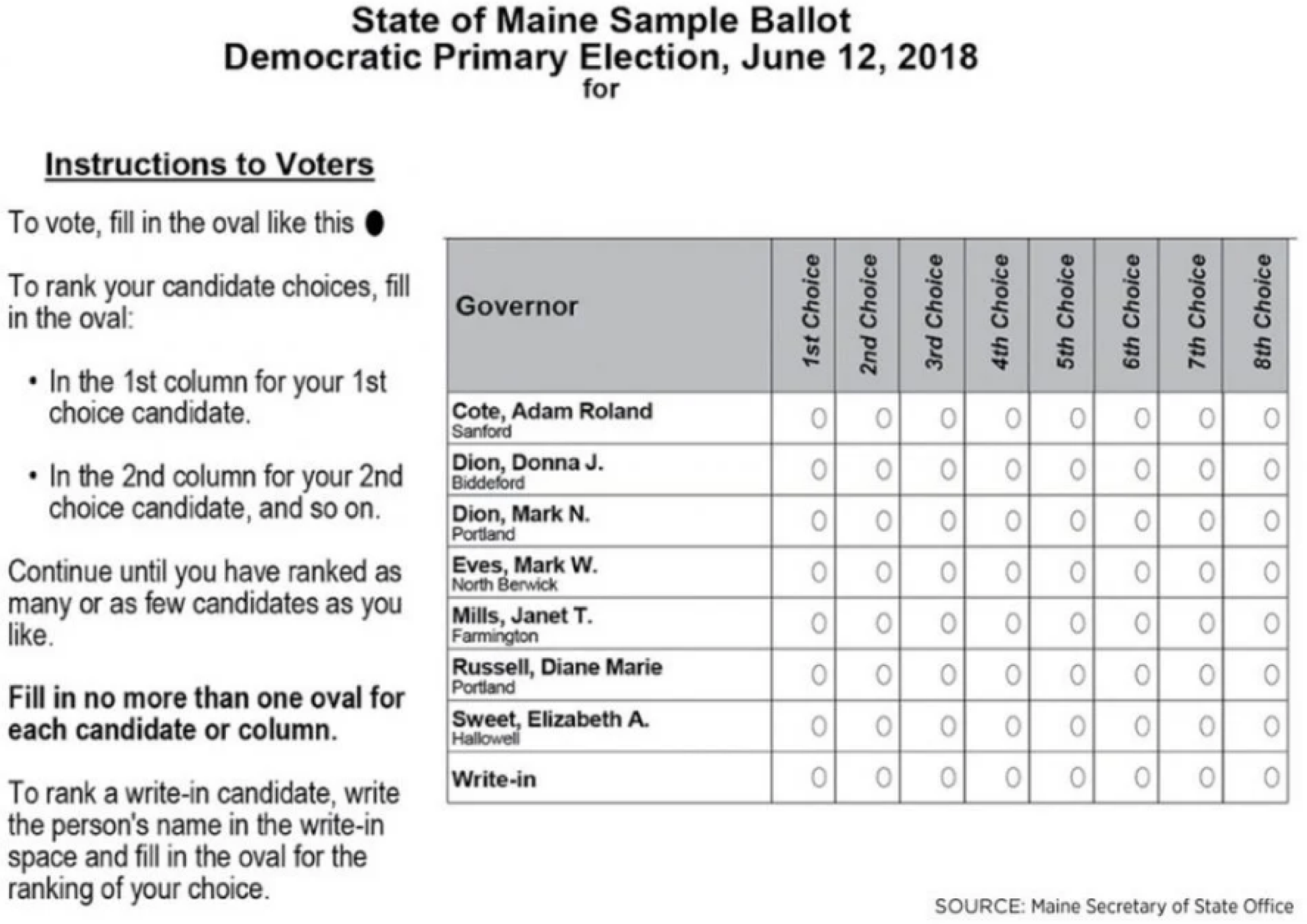
Results
We begin by investigating the effect of election rules on the selection of candidates of color in non-partisan elections. That is, what is the probability of a candidate of color being chosen compared to a white candidate when there is the lowest level of information? Our data are organized by candidate election, so that every candidate is coded as having been selected or not by the respondent.Footnote 6 Selected here means being ranked first in an RCV election, chosen in a plurality election, or being selected or ranked first or second in an at-large race. Later, we utilize the information from the full ranking of all four candidates in RCV contests, but to compare plurality and RCV races, we begin with a focus on voters’ top choices. We regress our Selected variable on indicators denoting the candidate race and interact candidate race with the election rule (RCV vs. plurality). We run an OLS regression that predicts whether a candidate is selected based on the candidate demographics, the electoral rule, and the interaction of those two treatments.
Figure 3 plots the coefficients from this regression and can be interpreted as the difference in the probability of a voter in the election choosing a Black (Asian, Latino/a) candidate compared to a white candidate in plurality rule elections and in the RCV elections. Because our candidate demographics are randomly assigned, these coefficients estimate the Average Marginal Component Effects, defined by Hainmueller, Hopkins, and Yamamoto as “the increase in the population probability that a profile would be chosen if the value of its lth component were changed from t0 to t1, averaged over all the possible values of the other components given the joint distribution of the profile attributes” (Hainmueller, Hopkins, and Yamamoto Reference Hainmueller, Hopkins and Yamamoto2014, 10).
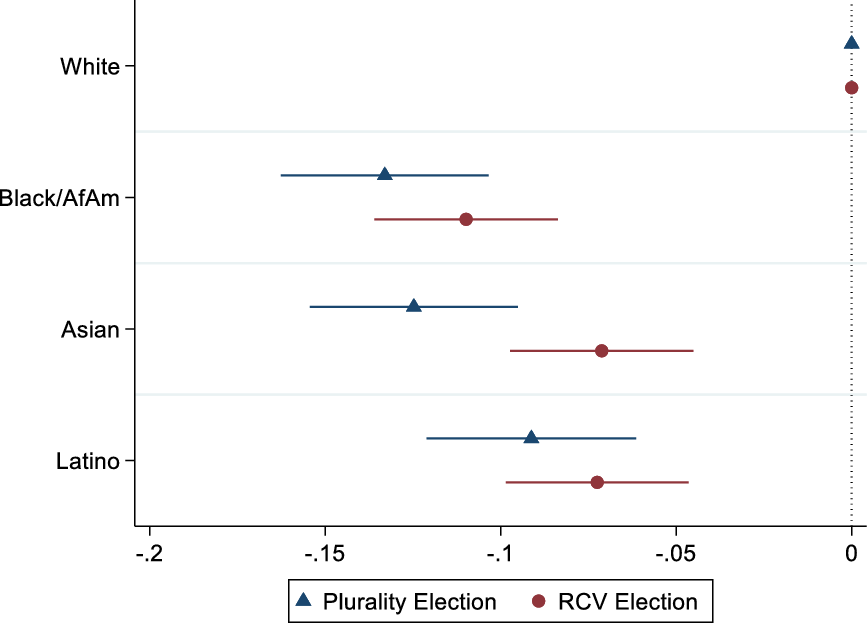
Figure 3. Effect of candidate race on vote choice in non-partisan elections, comparing RCV to plurality rule.
Candidates of color are generally penalized in non-partisan elections, compared to white candidates. That is, voters are less likely to choose a Black candidate (compared to white candidates) by approximately 13 percentage points in the plurality election, and in the RCV race, Black candidates are less likely to be ranked first by approximately 11 percentage points. The overlapping confidence intervals between plurality rule and RCV elections reveal that the electoral rules themselves have no significant effect on this penalty. The story is similar across the other racial groups – voters in very low-information elections are less likely to choose Asian candidates compared to white candidates by about 13 percentage points and less likely to rank them first compared to white candidates by about 7 percentage points. Latino candidates are similarly disadvantaged relative to white candidates, though the margin for Latinos across election rule types is even smaller than for other candidates of color.
Why do RCV elections appear to neither help nor harm candidates of color relative to plurality elections? One piece of suggestive evidence can be seen in how long our experimental voters took to make their vote decisions in each election type: respondents took significantly more time to vote in RCV elections compared to plurality elections (e.g., 27.0 s compared to 15.1 s in non-partisan mayoral elections). This is consistent with the possibility that the increased processing time (and “slow thinking”) required by ranking candidates in RCV elections may cancel out any negative effects of the greater complexity of RCV elections on voter support for candidates of color.
Do all respondents penalize candidates of color in these low-information elections? No. As shown in Figure 4, we find that this dis-preference for candidates of color is driven nearly completely by ideological moderates and conservatives and largely by white respondents (whites penalize all candidates of color in both RCV and plurality elections). Figure 4 shows the same OLS models from Figure 3 by separately by the ideology of the respondent (in the left panel) and the race of the respondent (in the right panel). The left panel reveals that liberal respondents are more likely to choose candidates of color than white candidates, but conservatives and moderates penalize Black candidates by a substantial 20 percentage points and 10 percentage points respectively. This penalty might come from racial animus or the perception than Black candidates are ideologically liberal (Jacobsmeier Reference Jacobsmeier2015) – we cannot tell from these data. Furthermore, conservatives and moderates are also less likely to select Latino or Asian candidates compared to whites.
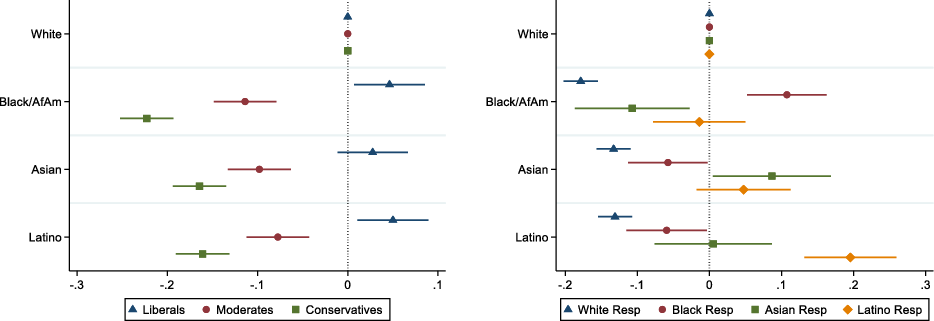
Figure 4. Effect of ideology and respondent race on vote choice in non-partisan elections.
Additionally, in the right panel, we see evidence of affinity voting. All respondents are more likely to choose a candidate who shares their racial categorization. However, the largest penalties for candidates come from white voters, who are about 15 percentage points less likely to choose Asian or Latino candidates and penalize Black candidates by an average of 20 percentage points relative to white candidates.
Figures 3 and 4 show the effects of candidate demographics and vote rules on very low-information election decision-making. An additional condition in our experiment enables us to see how providing an additional piece of information – a partisan cue – shapes the vote decision. Because partisan cues provide voters with an alternative heuristic, making it easier for them to avoid using racial cues and prejudices if they wish to do so, we expect that voters in partisan elections will demonstrate less bias against candidates of color than in non-partisan elections. Figure 5 reveals support for this expectation, as providing partisan labels significantly reduces the penalty for candidates of color in RCV elections. Within RCV elections, Black candidates are penalized about 10 percentage points compared to white candidates in non-partisan/low-information elections, but the penalty is reduced approximately 50% to 5 percentage points with the addition of partisan information. Our experiments also reveal that partisan labels reduce the penalty for candidates of color in plurality rule elections (shown in online appendix), suggesting that respondents utilize heuristics similarly across election type. In this way, too, RCV elections function similarly to plurality elections. Thus, non-partisan RCV elections (like other non-partisan elections) are likely to produce more racially biased vote choices than partisan contests.
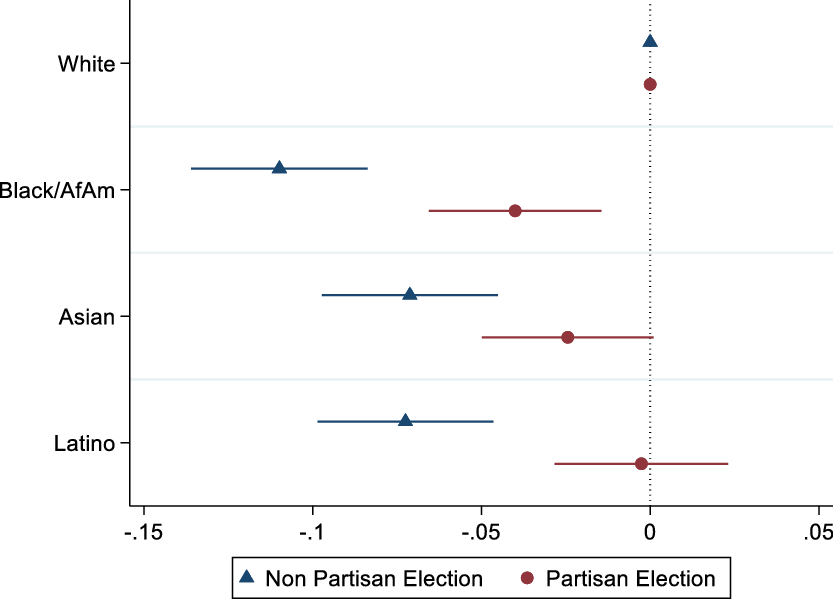
Figure 5. Effect of candidate race on vote choice in RCV elections, comparing partisan to non-partisan.
Coalition voting
One alternative way RCV can help candidates of color compared to plurality elections is by creating incentives for coalition building among candidates thereby allowing voters to avoid splitting their votes across candidates from different racial groups.Footnote 7 Our experiment cannot speak to the strategic nature of how candidates might campaign in an RCV setting and whether they might coordinate with other candidates; however, we can outline how voters in our low-information elections ranked candidates below those that were “selected” as the first ranked candidate. In Figure 6, we show the distribution of rankings by the race of candidate across non-partisan RCV local elections in which a single candidate is to be elected (e.g., for mayor and district city council). White candidates are chosen in the first rank, top slot 32% of the time, compared to 21% for Black candidates, 25% for Asian candidates, and 23% for Latino candidates. Beyond that first ranking, there is more parity across races – Black candidates are equally likely to be ranked second as whites, Asian and Latino candidates. Together, these rankings are consistent with the findings in Figure 2, revealing that white candidates will be more likely to win RCV elections than candidates of color even if rankings past first choices are taken into account. Adding together the first and second choices gives white candidates more votes than candidates of color and that remains true if adding the first through third choices or comparing the percentage of each racial group of candidates selected as fourth choice. However, it also suggests that because candidates of color and white candidates have fairly similar likelihoods of being ranked second, RCV could be at least neutral for candidates of color if vote counts proceed past the first round, depending on the distribution of votes. On the other hand, it is possible that the more frequent ranking of Black candidates in the lowest position suggests that in RCV contexts where voters are not required to rank all of the candidates, Black candidates may more often be left off of ballot rankings entirely relative to candidates from other racial or ethnic groups, reducing the overall votes they could potentially accrue as RCV ballots are sequentially tabulated.
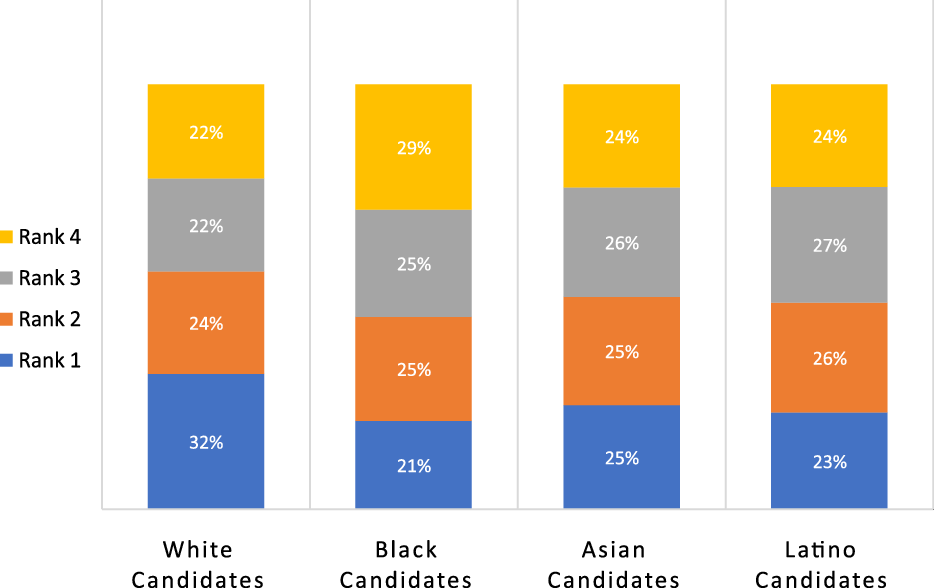
Figure 6. RCV rankings by candidate race.
Learning
If any penalties for candidates of color in RCV elections were due to the more complicated, unfamiliar nature of RCV relative to plurality elections, we might expect these penalties to decrease as voters learn more about RCV elections. Consequently, we fielded a second wave survey, in which about 15% of our sample voted in a second set of RCV elections six weeks after the first wave of the experiment. We find that even with more RCV experience, voters continue to penalize candidates of color. Hence, increased understanding of the RCV election process, and the potential reduction in cognitive load this might provide, is not sufficient to overcome the biases that emerge against candidates of color – in plurality elections, as well as in a voters’ first and second RCV voting experiences in our experiments.Footnote 8
Conclusion
As RCV expands to be used in additional localities across the US, it is important to evaluate how this type of election structure affects the candidates on the ballot and the voters choosing between these candidates. In this paper, we investigated whether RCV elections affect unequal representation by race and ethnicity present in American government. While more complex electoral environments have been shown to negatively affect voter support for candidates of color, this outcome seems not to be triggered by the somewhat complicated rules governing RCV elections. Rather, voters in RCV elections and those in plurality elections support candidates of color at similar (low) rates. Racial prejudices may simply be too powerful to be overcome by shifting electoral rules. Or, any negative effects of more cognitively taxing RCV elections on support for candidates of color may be counteracted by the slower thinking and movement beyond reflexive stereotypes and prejudices prompted by the process of ranking candidates.
We further find that the provision of additional information – such as partisanship – that leads voters in plurality elections to support candidates of color and white candidates at more equal rates appears to work similarly in RCV contexts. Thus, while ranked-choice elections may have a variety of effects on election outcomes, political parties, or voter attitudes (such as satisfaction with and trust in the election process), the evidence from this experiment is that RCV rules alone do not affect the likelihood of voters supporting candidates of color.
At the same time, the fears of some observers that RCV elections will be too difficult for voters to understand also appear unfounded in our experimental context. While voters in our experiments were initially less trusting of the electoral process when they voted in RCV elections, these negative attitudes disappeared with more experience. Further, a relatively brief practice with RCV in our experiments led respondents to be significantly more likely to understand how RCV elections work. However, this increased experience did not ameliorate or expand voters’ preference for white candidates over candidates of color. Additionally, observational data on the high rates of ballot spoilage in RCV elections (Benjamin and Burden Reference Benjamin and Burden2021) do still raise concerns that RCV would pose informational challenges for voters who are less motivated than experimental subjects or who have less access to comprehensive voter information packets. The results of our experiments reveal that, at least for the election of candidates of color, RCV does not provide a clear remedy to plurality elections.
Supplementary material
To view supplementary material for this article, please visit https://doi.org/10.1017/XPS.2023.6
Data availability
Support for this research was provided by the New America Foundation, through their ERRG initiative (www.newamerica.org/political-reform/errg), with support from Arnold Ventures. The data, code, and any additional materials required to replicate all analyses in this article are available at the Journal of Experimental Political Science Dataverse within the Harvard Dataverse Network, at: https://doi.org/10.7910/DVN/30EYIE.
Acknowledgements
We thank the Electoral Reform Research Group (ERRG) meeting participants for helpful feedback. Data collection was funded by New America, through their ERRG initiative (www.newamerica.org/political-reform/errg), with support from Arnold Ventures.
Conflicts of interest
The authors do not have any conflicts of interests to declare.
Ethics statement
This research was approved by the Institutional Review Boards at Davidson College (protocol 2020–052), Syracuse University (protocol 20–256), and the University of California Merced (protocol UCM2020-124) and adheres to the American Political Science Association’s Principles and Guidance for Human Subjects Research. Please see the Online Appendix for further details.











